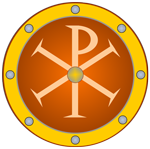
Battle of Bar |
year: 1042& October 1042 |
| Ruin of the Byzantines in a night ambush of the Serbs | ★ ★ ★ ★ ★ |
|
enemy: Serbs
|
location: At a gorge of mount Rumija, NE of the city Bar in Montenegro
|
accuracy:
●●●●●
|
|
battle type: Night attack |
war: Uprisings of the Serbs |
modern country:
Montenegro |
| ▼ The Byzantines(emperor: Constantine IX Monomachos) | ▼ The Enemies | |
| Commander: | Patrician Michael | Stefan Vojislav |
| Forces: | 40,000 (?) | Unknown |
| Losses: | 2/3 of the army | minimal |
| Background story: |
One of the many challenges that Emperor Constantine IX Monomachos had to face, during his reign, was the uprising of Duklja in the western Balkans.
Duklja (or, for the Greeks, Diokleia) was a medieval principality, which occupied, roughly, the area of present-day southern Montenegro. It was a Byzantine province that at times had been claimed by the Bulgarians. The inhabitants are referred to by the sources as “Diocletians” and were mostly Slavs (Serbs) and Illyrians. From 1014, the Byzantine archon of Duklja, based at the port of Bar, was Stefan Vojislav (or “Stefanos Voithslavos”). Stefan Vojislav In 1037 or 1038 Vojislav managed to escape from Constantinople, returned to Duklja and persuaded his people for a new revolt against Byzantium. This time the movement was successful and the governor Erotikos was expelled. The Byzantines reacted, but for a different reason: In 1039 the emperor Michael IV the Paphlagonian was staying in Thessaloniki and waited there for a ship loaded with gold from southern Italy. The ship sank on the rocks off the coast of Duklja and Vojislav appropriated the cargo. When Michael demanded the return of his gold, Vojislav ignored him. After this, the emperor sent against him a Byzantine army led by the inexperienced eunuch George Provatas, who was lost in the mountains, fell into ambushes and suffered a humiliating defeat. Vojislav then launched raids on other Byzantine territories, and quickly expanded to Dalmatia and present-day northern Albania. At some point, he even besieged Durres. Vojislav's activity and raids was a serious problem; a solution had to be found. In 1042 emperor Constantine IX wrote to the lord of Durres patrikios Michael ordering him to gather an army from Durres and from neighboring Byzantine regions and to squash the rebellion. |
The Battle: |
 the defeat of the Byzantines at Bar from the Skylitzes manuscript Michael marched to the north, but the problem was that he had the military experience or the skills to lead such a campaign. The Byzantine army entered the territory of Duklja without initially encountering resistance. Michael began to set plunder towns and villages in the lowlands, but as he was advancing, neglected to take measures to cover his back and to guard the straits into which was lured by the Montenegrins. On the night of October 7, after midnight, and while the Byzantine army was encamped in a mountainous area of Mount Rumija, northeast of Bar, a Serb entered the camp and began to shout “in fear” that a huge enemy army was heading towards them. This caused a great deal of unrest in the camp. The unrest became panic when the Serbs began to approach slowly and menacingly from the slopes to the sound of many trumpets to give the impression that they really had a large army. The Byzantines tried to retreat, but the passages were blocked by the Serbs, and found themselves trapped inside a gorge. Chaos ensued and the Byzantines, unable to defend themselves and without leadership, were at the mercy of the enemies who threw stones and arrows from the top of the gorge. The carnage continued all night and the next day! The victory was sealed in the end by the attack of the Serbian cavalry. The losses of the Byzantine army amounted to two thirds of its total strength. Seven Byzantine generals fell at the battlefield. |
Noteworthy: |
| The battle is considered a great historical event in modern Montenegro. October 7 is the national army day! |
Aftermath: |
| After this battle, Duklja gained its independence from Byzantium for over 100 years. Stefan Vojislav died the following year, in 1043, but his successors proved to be equally aggressive and competent. Duklja expanded and for a few decades was the most important Slavic state in the Balkans. In the 12th century, its power began to decline and gradually re-entered the sphere of influence of Byzantium. In 1186 it was annexed to Serbia and its period of autonomy ended. |
|
|
